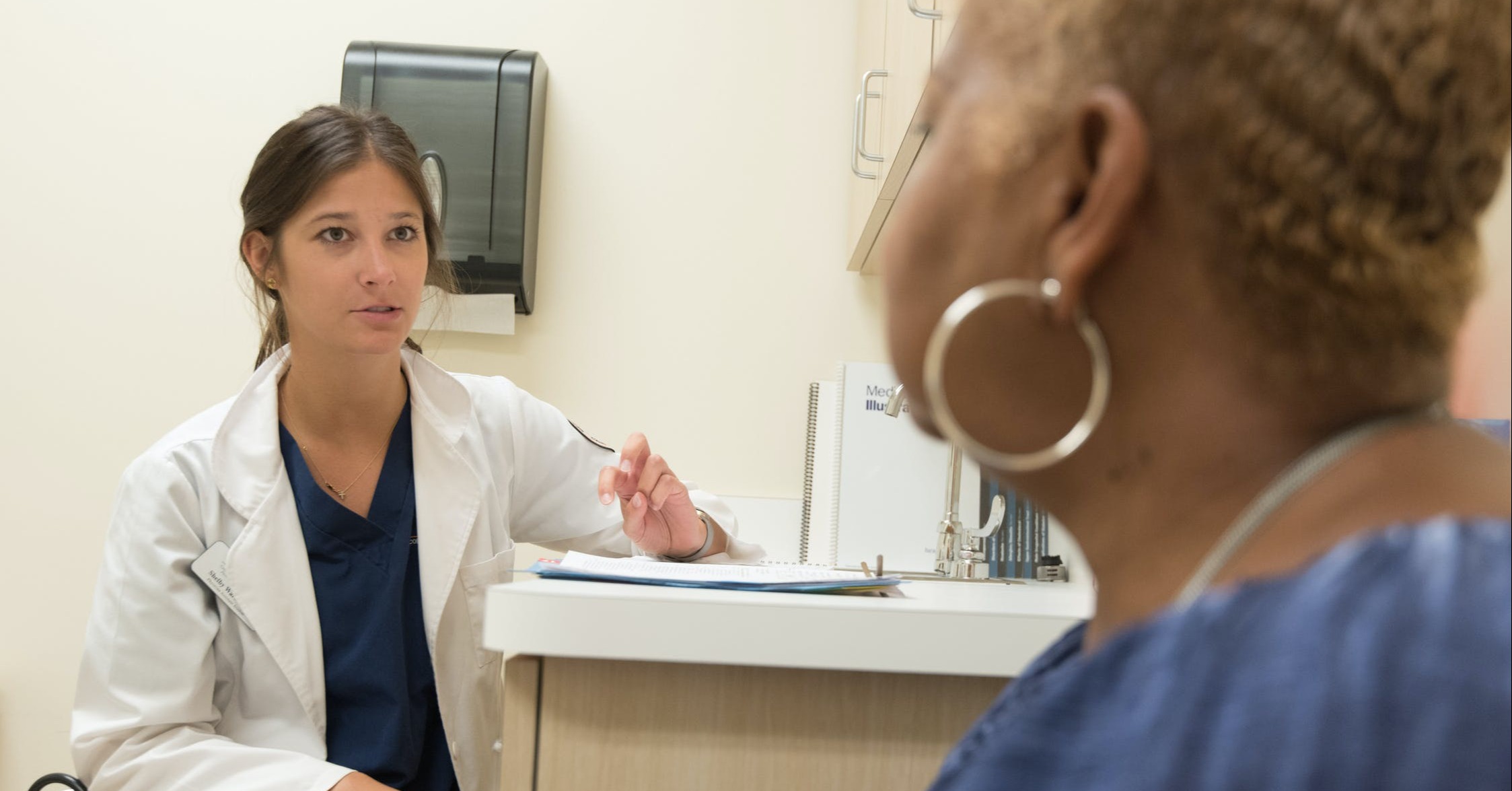
Physician Assistant vs. Doctor: What Is the Difference?
Physician assistants diagnose and treat patients, prescribe medication, and perform [...]

Physician assistants (PA) play an essential role in modern healthcare delivery. They consult with patients over 400 million times per year, according to the American Academy of Physician Assistants (AAPA), earning reputations as “trusted health care providers” who “improve the quality of healthcare.” PAs cannot run private practices, but they do independently deliver patient care (in accordance with state licensure regulations) in most healthcare settings.
PAs can work in hospitals, clinics, care facilities, and many other venues. According to the United States Bureau of Labor Statistics (BLS), 53 percent work in physician offices; 26 percent are employed by state, local, and private hospitals.
Given how much they do, it’s no wonder PAs are in high demand. The BLS says this job will grow at a breakneck rate (31 percent between 2020 and 2030). PAs earn an average annual income of $121,530, a figure that can go much higher depending on which of the 54 specialties the PA practices.
The typical PA master’s program lasts around two years, significantly less time than a Doctor of Medicine or Doctor of Osteopathic program. Even so, the process isn’t easy. Aspiring PAs compile extensive prerequisite coursework and work experience before entering the program. After graduation, a thorough licensure exam stands in the way of becoming a certified physician assistant.
This article addresses the question what is on the National Commission on Certification of Physician Assistants exam? It offers insight into the licensure process. It also covers:
Physician assistants must complete extensive training and education. Their master’s degrees include coursework and 2,000 or more hours of clinical rotations. Afterwards, they must pass the Physician Assistant National Certifying Examination (PANCE) to become certified. Considering education (undergraduate and graduate) and work experience, earning a license can take around ten years. That’s not including any additional certifications, fellowships, or training after becoming Physician Assistant-Certified (PA-C).
You’ll also need to meet state licensure requirements. To become state-certified, you’ll likely complete a background check, provide relevant transcripts, and pay a license fee.
You’ll also need to learn your home state’s practice limitations. Many states (39) limit the number of PAs a physician may supervise simultaneously to three or four. PAs are allowed to prescribe Schedule II-V medications in 44 states.
The PANCE consists of three hundred multiple-choice questions covering general medicine and surgical knowledge. Test-takers have five hours, including breaks, to complete the exam. You must be near completion of an accredited program to register for the test, which costs $550 to take. You cannot take the exam more than three times a year.
The exam itself tests the PA’s ability to assess and diagnose patients, plus conduct basic and complex interventions. The National Commission on Certification of Physician Assistants (NCCPA) released a summary of all the categories on the 2023 exam. The exam covers the cardiovascular system in depth (12 percent of all questions examining coronary artery disease, deep venous thrombosis, and diastolic heart failure) with 14 other categories constituting the remainder of the exam.
The second-most common categories are gastrointestinal system and/or nutrition (celiac disease, cholangitis, inflammatory bowel disease, infectious diarrhea) and pulmonary system (acute bronchiolitis, hypersensitivity reactions, asthma). Each accounts for ten percent of the test. Other categories include the dermatologic, reproductive, and endocrine systems, eyes, ears, nose, and throat, and infectious diseases.
The NCCPA website defines seven competencies every PA should know. They are:
Preparing for any test can be difficult, a five-hour marathon especially so. Top students typically start preparing before graduation, then complete the test after finishing their degree. Practice exams are a great way to study. Most students complete the Physician Assistant Clinical Knowledge Rating and Assessment Tool (PACKRAT), which simulates the actual licensure exam. It allows students to assess their deficiencies (and strengths) and alter their study plans.
Certified PAs must complete continuing education to avoid certification expiration. Over a ten-year cycle, they need to complete 500 hours of Continuing Medical Education (CME). They take the five-hour Physician Assistant National Recertifying Exam (PANRE) at the end of the tenth year. Starting in 2023, PAs can take a spread-out version of the recertification exam, commencing in their seventh year of practice and answering 25 questions per quarter. Both pathways require the same number of CME credits; each test costs $350.
A master’s prepares PAs for NCCPA certification. Several PA master’s degrees can offer PA education and prepare students for NCCPA certification. The degree may be called a PA Master of Science (MS), Master of Science in Medicine in Physician Assistant Studies, Master of Health Sciences (MHS), or Master of Clinical Health Services (MCHS). While the name of the degrees differ, each covers the content areas PAs need to earn their credential.
Students typically complete PA programs in two to three years, according to the AMA Journal of Ethics. Programs also commonly take around three years. Clinical rotations make it difficult to complete the degree on an accelerated timetable. That said, you can pursue a combination undergraduate-graduate degree in PA studies that takes five years to complete.
PA programs set strict admissions requirements. The AAPA reports that healthcare professionals, including nurses, EMTs, lab techs, and medical assistants, with three or more years of experience make up the majority of program applicants. Others with relevant experience qualify, too, including Peace Corps volunteers. Schools often require applicants to prove they have completed clinical hours. For instance, University of Pittsburgh students need to show evidence of 500 hours of patient work.
While completing a science bachelor’s degree isn’t necessarily a requirement, it’s challenging to get into a master’s program without one. Typical bachelor’s degree choices among applicants include physiology, chemistry, microbiology, biology, and anatomy.
PA programs are divided into two components. The first is required coursework, including microbiology, anatomy, pharmacology, and diagnosis. These classroom courses constitute the didactic portion of the program.
Students also complete at least 2,000 hours of clinical training across several specialties. They can focus on any after graduation. Popular rotations include family medicine, internal medicine, obstetrics and gynecology pediatrics, general surgery, emergency medicine, and psychiatry.
The AAPA identifies 54 subspecialties that fall into seven specialty areas. Top-paying subspecialties (and their median annual pay) include cardiovascular surgery ($137,000), thoracic surgery ($129,000), and emergency medicine ($124,100).
PA students can further specialize through electives. Another way to specialize is by earning a certificate of added qualifications (CAQ). For subspecialties like Cardiovascular and Thoracic Surgery (CVTS), you’ll need to complete continuing education and obtain more clinical knowledge in the area.
Top PA master’s programs includes:
These rankings may not give the full picture of what to look for in a program. According to a thread in the PA Forum, many people apply to a local program to access support from friends and family. If you’re transitioning to a PA career later in life, moving your family to a new location may be impractical.
Additionally, you may want to complete an online or hybrid (both online and in-person) program for convenience. Not many schools offer this option: University of Pittsburgh and Yale University offer two of the few.
Questions or feedback? Email editor@noodle.com

Physician assistants diagnose and treat patients, prescribe medication, and perform [...]

While online physician assistant programs do not offer virtual clinical [...]

Physician assistants diagnose, treat, and counsel patients, just as doctors [...]

he prerequisites for admission to a physician assistant master's program [...]

Physician assistant specialties include behavioral health, emergency medicine, family medicine, [...]
Categorized as: Physicians Assistant Studies, Nursing & Healthcare